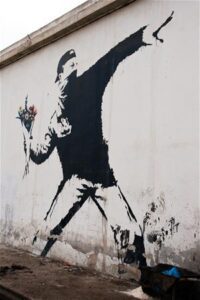The Cancellation Division of the European Union Intellectual Property Office (EUIPO) has invalidated a European Union trade mark (EUTM) registration representing Banksy’s iconic ‘Flower Bomber’ work (depicted below) on the grounds that it was registered in bad faith.
EUTM Registration
In 2014, Pest Control (the Proprietor) registered the following figurative ‘Flower Bomber’ mark as an EUTM for a wide range of goods and services.

The Proprietor is a handling service acting on behalf of the anonymous England-based street artist and activist, Banksy and has obtained a series of EUTMs for some of the artist’s most famous works.
Bad Faith Application
The applicant, a card company that reproduces street art on cards and related products, filed an application for a declaration of invalidity against the EUTM on the grounds of bad faith. The applicant argued that the EUTM, an exact reproduction of one of Banksy’s most iconic and famous pieces of work, had not been used by the Proprietor as a trade mark and had only been ever produced by Banksy as a work of art and not in connection with the provision of goods or services. The EUTM was, the applicant contended, registered with the sole purpose of preventing the ongoing use of the work by others.
EUIPO Determination
EUIPO acknowledged that, while there is no legal definition of the term bad faith, in order for a finding of bad faith to be made there must be:
- some action by the EUTM proprietor which clearly reflects a dishonest intention;
- an objective standard against which such action can be measured and subsequently qualified as constituting bad faith; and
- departure from accepted principles of ethical behaviour or honest commercial and business practices.
In finding that the EUTM had indeed been filed in bad faith, EUIPO emphasised that the purpose of a trade mark is to allow consumers to identify the commercial origin of the goods or services and not to prohibit others from registering or using signs with a view to carving out a portion of the commercial market.
EUIPO determined that it was clear that, when the Proprietor filed for the registration of the sign as an EUTM, he did not have any intention of using the sign to commercialise goods or provide services. Rather, his intention was to obtain an exclusive right to the sign for purposes other than those falling within the functions of a trade mark. Any use of the trade mark via the Gross Domestic Product homeware shop subsequently launched by the Proprietor to demonstrate use was only made after the initiation of proceedings and accordingly could not constitute genuine use.
Copyright Considerations
While the subsistence of copyright in ‘Flower Bomber’ fell outside the scope of the proceedings, the decision and the submissions raise some interesting questions regarding the role of copyright in protecting different kinds of original artistic works such as street art.
The purpose of copyright is to protect original artistic works. Street art could therefore be protected by copyright if the relevant qualifying criteria are met. Banksy has in the past made numerous statements in which he claims that “copyright is for losers”. This may be attributable to the fact that by asserting copyright over his works he would likely jeopardise the anonymity of ‘Banksy’ and prejudice his elusive persona. This is the case with many street artists who choose to remain anonymous.
Banksy has instead sought to protect his works from commercialisation by third parties through the registration of trade marks by businesses that represent him. However, this practice may have unfair consequences. Trade marks, unlike copyright which has a fixed duration, can be renewed indefinitely. The registration and recognition of an exclusive right to use an artistic work (more appropriately covered by copyright) indefinitely could enable proprietors to hold a monopoly over the work and restrict the free exchange of cultural ideas and expression.
Key Impacts
EUIPO’s decision serves to remind those seeking to protect works of art as figurative trade marks, that EUIPO interprets the concept of bad faith broadly, and accordingly, there must be some genuine intention, at the date of filing, to use the trade mark as a badge of origin to sell goods and services of the proprietor.


